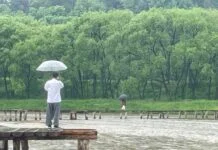(Meida1=William Harlow) Not far from Geojedo as the crow flies is Tongyeong; however, due to the irregular jagged coastline, it takes about a half hour to get there by inter-city bus.
At the Tongyeong bus terminal there is a tourist information booth, taxi stand, and city bus stop. At the bus stop is a detailed list of what bus will take you to what part of the city and the related attractions.
Still, you may have to wait a while as Tongyeong city is a combination of a bunch of smaller cities combined into the larger Tongyeong whole. This results in numerous bus routes and a potential wait for the right one to come along. Also, the smaller nature of the city makes the frequency of busses less than one familiar with Seoul would be used to.
We took a bus that went to the main bay near the old part of the city. Here was where the main naval headquarters was for the Joseon Dynasty (1392-1910). Around the harbor were many inexpensive hotels, restaurants, coffee shops, and a large traditional market with many seafood vendors (Boss likes fresh sea urchin; I ate at the waterfront “Subway” restaurant). The location was ideal and we decided to use this as our home base for the next few days.
The small bay was surrounded by hills and is very scenic. There is a self-guided walking tour if you so desired. On the east and west cliffs overlooking the bay are small Korean naval outposts from the Joseon era (reconstructed).

On the hill overlooking the north end of the bay is a restored complex of the old Joseon naval headquarters of the 16th century. The headquarters is restored to how it would have looked during the Imjin War (1592-1598) where Korea (Joseon) successfully resisted a Japanese Invasion lead by their most famous naval hero Admiral Yi Sun-shin.
In the harbor are reproductions of Joseon era naval vessels including three of the famous turtle boats (Geobukseon) (the first ironclad vessel) and one of the larger fighting vessels called a Panokseon. For a small fee of 2000 won ($2) you can tour these ships at your leisure. This is something well worth doing.
On our first day in Tongyeong we decided to do the walking tour. It starts at the north end of the harbor near the turtle boats. This section of the town has markers that highlight aspects of the Joseon naval headquarters as well as local artists and writers who have made contributions to Korean culture. (Note: The manhole covers are interesting as they have a depiction of the turtle boat embossed on their center.)
First we walked passed the main market to the east cliff outpost or fort. On the way you go through a neighborhood that is often used as a backdrop for Korean television dramas. The area has many artistic murals painted on the walls and walkways.
It is said that many years ago the government wanted to rebuild the old walls that use to surround the Joseon naval base; however the residents of the area objected. The compromise was the rebuilding of the east cliff fort and an artistic area on the surrounding hills. The area also has some nice gardens, coffee shops, and a visitor information center. From the walls of the outpost you have an excellent view of the bay.
The next stop was across the harbor to the west cliff fort. This was quite a walk; however, it did give you a different perspective of the area. The west cliff outpost is also surrounded by some nice walking trails to include a musical trail and a trail with numerous butterfly murals. From the west hill fort we followed the streets along the hills contours to the main Joseon naval headquarters.
Here you have to pay a small (2000 won) admission fee and are then free to tour the complex.
The complex is relatively large. Here you can see pagodas and administrative structures restored to how they would have looked in the late 16th century. There are displays of flags, weapons, blacksmith shops, and command and control facilities. There is even a reproduction of Admiral Lee Sun-Shin’s personal quarters with a reproduction of his huge sword. From this headquarters, Admiral Lee lead an naval campaign against the Japanese invasion that culminated in the famous battles of Dangpo and Hansando (9 July and 14 August 1592) that defeated the Japanese using the famous Crane Wing formation and skillfully using the islands along the coast to deny the Japanese access to the southern coast of Korea. It was lots of fun to see.

It was getting late and we were getting hungry so we went down the hill a few hundred meters and found ourselves on the main street of the town (about a block away from the harbor). Here we went to “Mom’s Touch” (a chain of chicken and burger restaurants you find in Korea that was pretty good and very reasonable) and had a great meal.
After the late lunch, we went back to the harbor, toured the turtle boats, then went to the market and bought some seafood for dinner. We had done a lot of walking up and down hills and through the picturesque back streets.
It was an interesting tour that was both historical and scenic. It was interesting to see the city that had grown up around the old Joseon naval base. We were bone tired by the time we got back to the hotel. Tomorrow we had new adventures planned in Tongyeong.



![[기획 2편] 가덕도는 왜 계속 돌아오는가 – 공항 입지의 정치학](https://media1.or.kr/wp-content/uploads/2025/05/크기변환크기변환또변환ftgjfjKakaoTalk_20250515_193237704-324x235.png)






